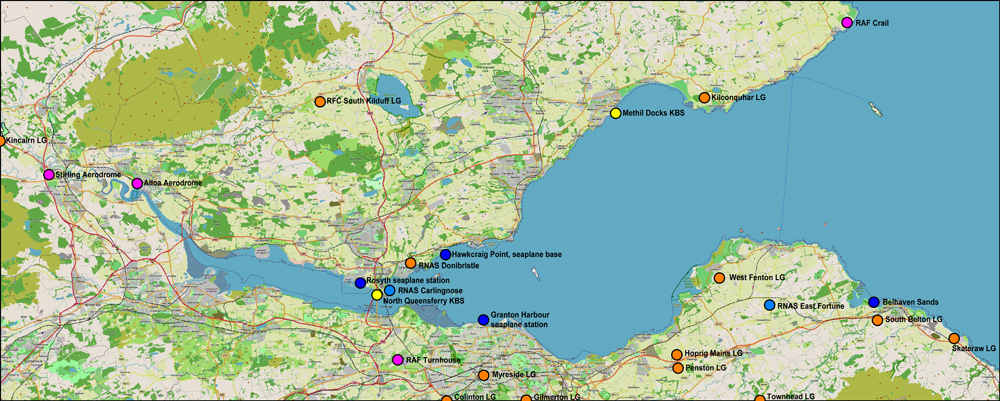Military Aviation round the Forth in WWI
Introduction
While the concrete structure of fortifications and gun batteries have left a lasting physical legacy, most of the once extensive WWI aviation sites around the Forth have vanished from the landscape.
 WWI airbases around the Forth
WWI airbases around the Forth
There are more details about Military Aviation during WWI HERE
Around the Forth there was considerable activity in Aircraft Production and in the operations of the Royal Naval Air Service, and the Royal Flying Corps Military Wing.
Aeroplane production
Before WWI, Britain was lagging in the development and production of aircraft. Aeroplanes were bought from French manufacturers – Henry and Maurice Farman, Bleriot, Deperdussin, Borel. In 1913, the Royal Aircraft factory was given permission to design British aircraft. These designs were then built at factories throughout the UK, including The Cauldron Aeroplane Factory and Aerodrome at Alloa.
Royal Naval Air Service
The Royal Naval Air Service initially used land-based seaplanes for coastal defence observation, and airships for long-range spotting.
They also had ship-based equipment. Kite Balloons tethered to ships improved observations, while ship-borne seaplanes were used as scouts and as bombers. This led to the development of aircraft carriers which could launch and land aeroplanes for offensive operations.
There were several RNAS Stations around the Forth in WWI
RFC Military Wing
In Britain, the RFC Military Wing was initially focussed was on training pilots to fight on the front-line.
In the early stages of the war aeroplanes were used as reconnaissance scouts, then fighter planes were developed to attack the scouts. British and German twin-engine heavy bombers arrived in 1917 to complement German Zeppelins, which had bombed cities in Europe from the first weeks of the war.
In 1916, Zeppelin raids on Britain led to the formation of home defence squadrons equipped with fighter aeroplanes to ward off these attacks.
There were several RFC Aerodromes and Landing Grounds around the Forth in WWI
Closure of WWI Military Air Stations
Many of the RFC emergency landing grounds were very short lived. Colinton opened in October 2016 and closed in December 2016; presumably it was in too tight a space.
Penston I opened in December 2016 and closed in January 2017, when the site transferred across the road to Penston II
Kincairn and Hoprig Mains closed in March and June 2017 respectively.
Myreside went in 2018.
Most of the remaining Landing Grounds – South Kilduff, Whiteburn, Cairncross, Gilmerton, South Belton, Penston II, Skateraw, Eccles Tofts, Tynehead, Townhead, and Kilconquhar closed in 1919.
Many Navy-related activities ceased at the end of 2018, when the bulk of the German High Seas Fleet was interned at Scapa Flow.
These included the Kite Balloon Stations at North Queensferry and Methil Docks; the Granton Harbour Seaplane station and the torpedo dropping trials at Belhaven Sands.
HMS Tarlair at Hawkcraig Point in Aberdour closed in 1919.
1918 – Creation of the Royal Air Force
In April 1918, the Royal Flying Corps (RFC) and The Royal Naval Air Service (RNAS) combined to form the Royal Air Force (RAF).
All existing stations became RAF stations. One new station opened around the Forth in 1918 – RAF Crail.
RAF Crail opened in July 1918, as a training station for fighter reconnaissance aircraft such as the Avro 504K and Royal Aircraft Factory F.E.2b. The American 120th Aero Squadron was at Crail in 1918, and No 104 Squadron RAF in 1919. The airfield was closed in 1919 and lay dormant until the Second World War.
1919 – Surviving Air Stations
In 1919, the surviving stations and aerodromes were:
Alloa Aerodrome, RAF Turnhouse, RAF Stirling, RAF Crail, RNAS East Fortune (RAF East Fortune), RAF West Fenton (RAF Drem), RNAS Donibristle, RNAS East Fortune and further afield RAF Horndean (near Berwick) and RAF Leuchars (which opened in November 1918 as the Grand Fleet School of Aerial Fighting and Gunnery.
Alloa Aerodrome closed in 1925, but the others survived (although some were moth-balled) until WWII.
Back to Military Aviation around the Forth
top of page
